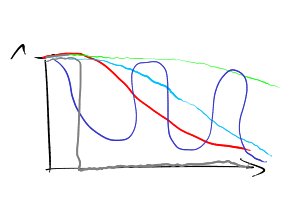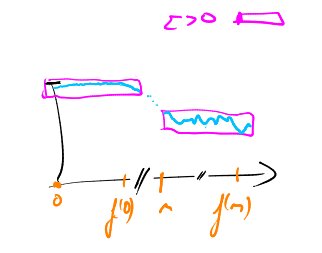Flat Ultrafilters (Michigan Logic Seminar Sept 21, 2011)
Remember how our about page says that Booles' Rings is about best practices for an academic homepage? Ok, let's try one: making notes to talks available.
Some introductory remarks
Skip this section if you only want mathematics.
Wednesday, I gave a short talk about flat ultrafilters at our Logic Seminar here at the University of Michigan (as announced on Set Theory Talks, the talk was recorded and the video will be online eventually is now online).
Flat Ultrafilters (2011/09/21 University of Michigan Logic Seminar) from Peter Krautzberger on Vimeo.
When I visited Toronto in June, Ilijas Farah introduced me to this somewhat strange new type of utrafilter on
I would like to explain something about the result that P-points are not flat. When I started looking at their paper with Francois Dorais, we first re-proved that selective ultrafilters are not flat -- instead of the (possibly stronger) functional analytic result from the paper we used the combinatorial definition of flat ultrafilters. Then we worked on improving that proof and, with Andreas's help, got it to work for P-points.
Only after all of this happened did we notice that at the very end, the paper had already announced that they have a proof that P-points are not flat. Last week, Ilijas kindly send me some slides with further results on flat ultrafilters; even though the proof for P-points isn't in there I would guess from the formulation on the slides that our proofs are essentially the same.
Long story short, the proof "P-points are not flat" below is "our" proof even though the result (and most likely the proof) should be credited to at least Steprans (according to the slides).
I will focus on my own interpretation of these notions, i.e., my rephrasing of the definition of flat ultrafilters; they might look different from what you'll find in their paper even though it is formally the same notion.
Alright, nuff said. My talk was designed to first sketch the main functional analysis result of their paper. So the first two sections will be void of much explanations or proofs. But they motivate why the notion of flat ultrafilter is as strange as it is -- it simply came out of those considerations.
Some functional analysis
Let
Then
and
Finally, the Calkin Algebra is the quotient
Farah, Philips and Steprans were interested in the relative commutant of subalgebras
The relative commutant in the ultrapower
If
(Similarly for
Kirchberg had shown that
As a response, Farah, Philips and Steprans showed that
Theorem (Farah, Philips, Steprans)
If
is a flat ultrafilter (see below), then . If
is selective, then ; in particular, selective ultrafilters are not flat. Flat ultrafilters exist under ZFC.
It was announced that P-points are not flat.
Curious fact: under CH all ultrapowers of
If you look at the recording you will, as usual, see lots of confusion on my part. In particular, I remembered that the first result in the theorem was an equivalence. It turned out that the paper does not say so and this is an open question. In my defence, the slides did give it as an equivalence.
I'll only give the proofs of the last two statements as well as some further observations on flat ultrafilters.
Flat ultrafilters
What are flat ultrafilters? Well, let's first introduce the assisting structure of a flatness scale, a set of sequences in
Definition
A flatness scale H is a countable subset of
Addendum Nothing spectacular so far -- a flatness scale is just a bunch of sequences converging to

The original definition of flat ultrafilters is then phrased as follows.
Definition [Farah, Philips, Steprans]
An ultrafilteris flat if there is a flatness scale such that for every increasing with In other words, for every
as above and every , we have We then say that
is a flatness scale for p.
One of the goals was to find out how I can best think about the notion of flat ultrafilters.
Addendum What to make of this? The first observation is that flat ultrafilters have a flatness scale such that, given

One of the things I found irritating was to think of them as ultrafilters on
Definition [reformulation] Given a flatness scale
and an ultrafilter on , we say that is flat , if for every increasing with and every , In other words,
Here
You might wonder if we're not loosing too much information -- after all, the original definition did not forbid repetitions. We'll see later that this is not a problem. For now, I will simply stick to the reformulation.
First there's an obvious question about how complicated a flatness scale can be. So let me show you their construction of flat ultrafilters.
Constructing Flat Ultrafilters
A simple observation
For the construction of flat ultrafilters, the key observation is as follows: all we have to do is find a flatness scale
are infinite for every increasing
Once we have this, we get the finite intersection property for free since
In other words, any ultrafilter
Luckily, It turns out that there is an extremely simple flatness scale with this property.
Proposition [Farah, Philips, Steprans] There is a flatness scale
such that the set is infinite for every increasing
with and every .
Proof
- Consider the finite subsets of
, . - We can think of
as encoding a simple step function, dropping by at each of the elements of ; in other words, we define by
- Clearly,
is a flatness scale (starting at and converging to zero, in fact being eventually zero). - Now imagine we're given some increasing
with as well as some . - Then we can easily find infinitely many
with the following properties: - With the natural enumeration of
of ,
for each . - But this means that for all
,
- It follows that
. - Since we can find infinitely many such
, the sets are all infinite.
Combining this with the previous observation we have.
Corollary (Farah, Philips, Steprans)
There is a flat ultrafilter via the above flatness scale
Some easy observations
Let's try to get a feel for what we can actually expect from a flat ultrafilter.
For example, a flat ultrafilter must be non-principal -- otherwise the flatness scale is just one map and it's easy to find
Flatness scales are simple
The above results from Farah, Philips and Steprans is surprising: at first since the flatness scale is extremely simple! It's only natural to ask how complicated flatness scales can really be. Luckily, it's always this easy!
Proposition If
is flat, then as above is a flatness scale for .
Proof
- Assume we have a flatness scale for
, say with some fixed enumeration of . - We can define another flatness scale as follows: simply choose
to be a multiple of closest to , i.e., minimize . - Clearly,
. - Then
(and hence ) is a flatness scale for ! - For
as in the defintion for flatness, we know
- But
. - Since all but finitely many
have we have
- In other words, both sets lie in
-- as desired.
- For
The above proposition tells us that we can now think of flat ultrafilters as simply living on
Definition revisited. An ultrafilter
is flat if for all with and ,
We're still sort of hiding the fact that we can vary the bijection between
Convergence in the colums
The next important observation is that in each coordinate
Lemma If
is flat, then for all .
Proof
- Suppose
for some and . - In other words,
. - Pick some
, increasing with (note since ). - Then
for every . - In other words,
- But this contradics
.
A proof that P-points are not flat.
In their paper Farah, Philips and Steprans announced that P-points are not flat. Francois, Andreas and I overlooked that statement and re-proved the result as follows. (See also the comments at the beginning as well as later.)
Suppose for this section that
As the first step, we will improve the p-convergence from earlier to actual convergence, i.e.,
In the second step, we will show that no ultrafilter can have such a flatness scale.
Lemma If
is a flat P-point, then contains that satisfies for every .
Proof
- Since
for all we know that for all . - Since
is a P-point, we find such that for all . - But that means precisely that
has for every . - Of course, restricting to
does not change the fact that holds for every increasing function with -- so we're done.
We may thus suppose that our original flatness scale satisfies
Lemma No ultrafilter
has a flatness scale with .
Proof.
-
Else, for any fixed
, there are only finitely many such that . -
For these finitely many
, there is a common (depending only on ) such that , and thus for all . -
In other words, we can define
be an increasing function with such that if then . -
Since
is a flatness scale, we have that
- So pick one of those
, i.e., with for all . - For this fixed
we can, of course, find the first such that . (Note that since .) - Since
and , we see that
by our choice of
- Therefore,
. - By choice of
, we have that and hence -- which contradicts our choice of !
Flat ultrafilter and rapidity
Since selective ultrafilters are not flat, I was for the longest time under the impression that Q-points and, more generally, rapid ultrafilters might be connected.
(Un)fortunately, this is not the case. An easy argument yields flat but rapid ultrafilters.
Proposition If
is flat and , then is flat. By contraposition, if is not flat, then is not flat.
Proof.
- If
is a flatness scale for and with , then is a flatness scale for . - Given
and , simply calculate
- Given
This is all we need.
Proposition If there exists a rapid ultrafilter, there exists an ultrafilter both flat and rapid.
- Take
rapid, and flat. - Then
is rapid and flat - Flat, since
. - By a folklore exercise, if
is rapid, then any is rapid.
- Flat, since
That's about all I actually covered in my talk. There might be a continuation at a later point.
2011/09/29 I added some badly drawn pictures and additional comments (preceded by "Addendum")